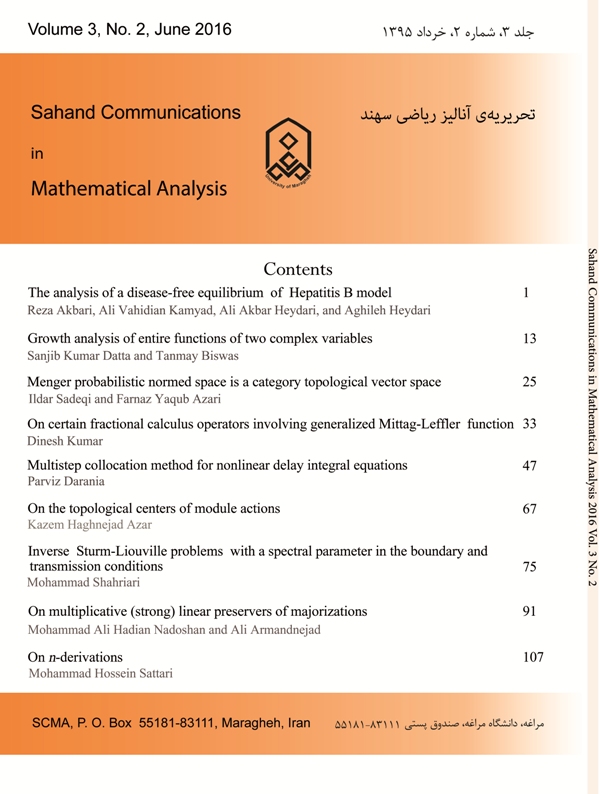[1] R.M. Anderson and R.M. May, Infectious Disease of Humans: Dynamics and Control, Oxford University Press, Oxford, 1991.
[2] S. Bhattacharyyaa and S. Ghosh, Optimal control of vertically transmitted disease, Computational and Mathematical Methods in Medicine. 11(4) (2010) 369-387.
[3] S. Bowong, J.J. Tewa, and J.C. Kamgang, Stability analysis of the transmission dynamics of tuberculosis models, World Journal of Modelling and Simulation. 7(2) (2011) 83-100.
[4] P.V.D. Driessche and J. Watmough, Reproduction numbers and subthreshold endemic equilibria for compartmental models of disease transmission, Math Biosci. 180 (2002) 29-48.
[5] Y. Enatsu, Y. Nakata, and Y. Muroya, Global stability of SIRS epidemic models with a class of nonlinear incidence rates and distributed delays, Published in Acta Mathematica Scientia, 32 (2012) 851-865.
[6] H. Hethcote, The mathematics of infectious diseases, SIAM Review, 42 (2000) 599-653.
[7] J.C. Kamgang and G. Sallet, Computation of threshold conditions for epidemio-logical models and global stability of the disease-free equilibrium (DFE), Mathematical Biosciences, 213 (2008) 1-12.
[8] A.V. Kamyad, R. Akbari, A.A. Heydari, and A. Heydari, Mathematical Modeling of Transmission Dynamics and Optimal Control of Vaccination and Treatment for Hepatitis B Virus, Computational and Mathematical Methods in Medicine. Volume 2014, Article ID 475451, 15 pages.
[9] T.K. Kar and S. Jana, A theoretical study on mathematical modelling of an infectious disease with application of optimal control, Bio Systems, 111(1) (2013) 3750.
[10] T.K. Kar and A. Batabyal, Stability analysis and optimal control of an SIR epidemic model with vaccination, Biosystems. 104 (2011) 127-135.
[11] X. Liu and L. Yang, Stability analysis of an SEIQV epidemic model with saturated incidence rate, Nonlinear Analysis: Real World Applications, 13 (2012) 2671-2679.
[12] J. Mann and M. Roberts, Modelling the epidemiology of hepatitis B in New Zealand, Journal of Theoretical Biology. 269 (2011) 266-272.
[13] G.F. Medley and N.A. Lindop, Hepatitis-B virus endemicity: heterogeneity, catastrophic dynamics and control, Nature Medicine, 7(5) (2001) 619-624.
[14] A.A. Momoh, M.O. Ibrahim, and B.A. Madu, Stability Analysis of an Infectious Disease Free Equilibrium of Hepatitis B Model, Research Journal of Applied Sciences, Engineering and Technology, 3(9) (2011) 905-909.
[15] J.S. Muldowney, Compound matrices and ordinary differential equations, Rocky Mountain J. Math. 20 (1990) 857-872.
[16] J. Pang, J.A. Cui, and X. Zhou, Dynamical behavior of a hepatitis B virus transmission model with vaccination, Journal of Theoretical Biology. 265 (2010) 572-578.
[17] S. Sun, Global Dynamics of a SEIR Model with a Varying Total Population Size and Vaccination, Int. Journal of Math. Analysis, 6(40) (2012) 1985-1995.
[18] C. Sun, Y. Lin, and S. Tang, Global stability for an special SEIR epidemic model with nonlinear incidence rates, Chaos, Solitons and Fractals, 33 (2007) 290-297.
[19] S. Thornley, C. Bullen, and M. Roberts, Hepatitis B in a high prevalence New Zealand population: A mathematical model applied to infection control policy, Journal of Theoretical Biology. 254 (2008) 599-603.
[20] P. Van Den Driessche and J. Watmough, Reproduction numbers and subthreshold endemic equilibrium for compartmental models of disease transmission, Mathe- matical Biosciences, 180 (2002) 29-48.
[21] K. Wanga, A. Fan, and A. Torres, Global properties of an improved hepatitis B virus model, Nonlinear Analysis: Real World Applications, 11 (2010) 3131-3138.
[22] WHO, Hepatitis B Fact Sheet No. 204, The World Health Organisation, Geneva, Switzerland, 2013, http://www.who.int/mediacentre/factsheets/fs204/en/.
[23] S. Zhang and Y. Zhou, The analysis and application of an HBV model, Applied Mathematical Modelling, 36 (2012) 1302-1312.
[24] S.J. Zhao, Z.Y. Xu, and Y. Lu, A mathematical model of hepatitis B virus transmission and its application for vaccination strategy in China, Int.J.Epidemiol. 29 (2000) 744-752.
[25] L. Zou, W. Zhang, and S. Ruan, Modeling the transmission dynamics and control of hepatitis B virus in China, Journal of Theoretical Biology, 262 (2010) 330-338.

